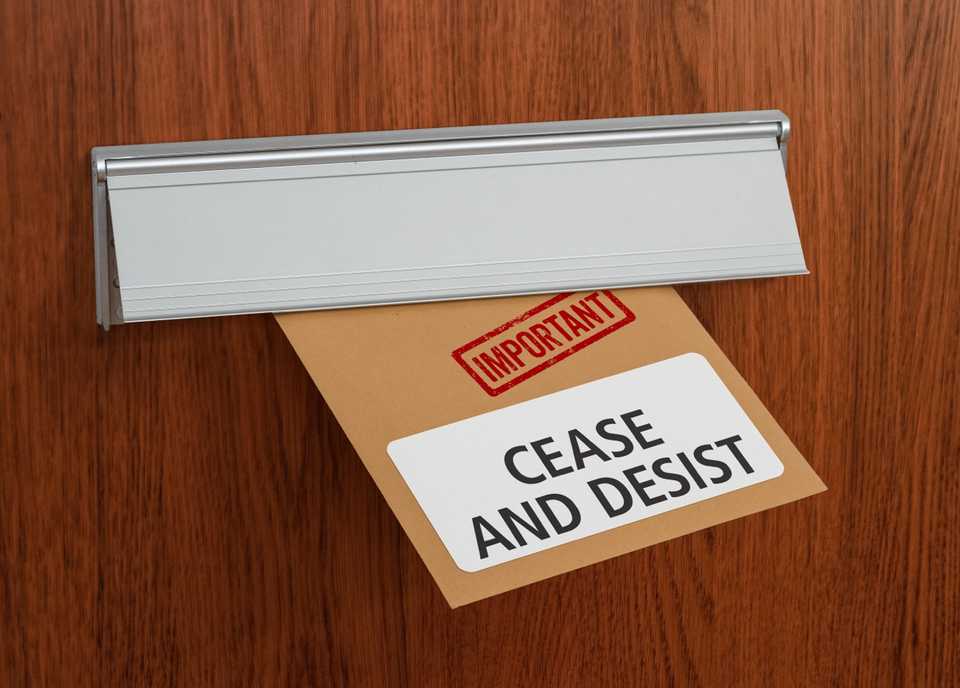Cease and desist letters are commonly used in various legal contexts, including intellectual property infringement, harassment, defamation, contract disputes, and more.

Essentially, it is a written communication sent to an individual or entity that is engaging in unauthorized or infringing activities. The purpose of the letter is to demand that the recipient immediately stop the specified behavior and refrain from any further infringement.
Crafting an Effective Cease and Desist Letter: Key Elements and Best Practices
Identify the Infringing Behavior
In the context of Canadian law, when asserting your rights or claiming that your rights have been infringed upon, it is essential to clearly specify the actions or behaviors that are infringing upon your rights or causing harm.
By clearly outlining the specific actions or behaviors, you provide a detailed account of the violation or harm that has occurred.
When making a claim or asserting your rights, it is important to support your case with evidence. Providing detailed evidence, such as:
- copies of relevant documents,
- screenshots,
- or other supporting materials
can significantly strengthen your position and lend credibility to your claims.
The crucial role of evidence … Evidence serves as a factual basis for your assertions and demonstrates the nature and extent of the infringement or harm you have experienced.

For example, if you believe your privacy rights have been violated by a company, you might provide copies of relevant documents, such as emails or contracts, that demonstrate how your personal information was mishandled or shared without your consent.
You could also include screenshots of online interactions or records of communication that support your claim.
Similarly, if you believe you have been discriminated against in the workplace, you might provide evidence such as emails, memos, or witness statements that document instances of discriminatory behavior or unfair treatment.
By providing detailed evidence, you not only strengthen your case but also enable the parties involved, including courts or other legal bodies, to assess the validity of your claims and take appropriate action.
It is crucial to compile and present your evidence in a clear and organized manner, ensuring that it is relevant, reliable, and directly supports your allegations.
Haut du formulaire
Bas du formulaire
You can’t assert what you don’t identify – State Your Rights
When asserting your rights and claiming that they have been infringed upon, it is crucial to clearly state the specific legal rights that are being violated.
These rights can include copyright, trademark, or contractual rights, among others.

By explicitly identifying the legal rights at stake, you provide a clear framework for understanding how the recipient's actions are infringing upon these rights and why they are in violation of the law.
- Copyright Infringement
Copyright is a legal right that grants creators the exclusive control over their original works of authorship, such as literary, artistic, musical, or dramatic creations.
If someone reproduces, distributes, displays, performs, or creates derivative works of your copyrighted material without your permission, they may be infringing upon your copyright.
You can assert your rights by demonstrating that the recipient has used your copyrighted work without authorization and provide evidence such as copies of the original work and evidence of the unauthorized use.
- Trademark Infringement
Trademarks are distinctive signs, symbols, or expressions that identify and distinguish the goods or services of one party from those of others. If someone uses a trademark that is confusingly like yours in connection with similar goods or services, they may be infringing upon your trademark rights.
To establish trademark infringement, you would need to demonstrate that the recipient's use of a similar mark is likely to cause confusion among consumers and harm your brand.
- Contractual Rights Violation
Contractual rights arise from agreements between parties, where each party has certain obligations and entitlements. If someone fails to fulfill their contractual obligations or breaches the terms of a contract, they may be violating your contractual rights.
To establish a contractual rights violation, you would need to provide evidence of:
- the existence of a valid contract,
- the specific provisions that have been violated,
- and how the recipient's actions have breached those provisions.
This could include copies of the contract, relevant correspondence, or any other documentation that demonstrates the breach.
By clearly stating the specific legal rights being violated and explaining how the recipient's actions infringe upon these rights, you provide a solid legal foundation for your claims.
It is important to consult with a lawyer or legal expert specializing in the relevant area of law to ensure that your claims accurately reflect the legal framework and requirements specific to your jurisdiction.
Demand Immediate Cessation
When addressing an infringement of your legal rights, it is crucial to assertively demand immediate cessation of the infringing behavior.
Clearly and unequivocally communicate to the recipient that their actions are in violation of your rights and that they must cease and desist without delay. In doing so, it is important to provide a specific deadline by which the recipient must comply with your demand.

By explicitly stating your expectation for immediate cessation, you make it clear to the recipient that their ongoing infringing behavior is unacceptable and needs to be halted promptly. This puts the recipient on notice of the urgency and seriousness of the situation.
When specifying a deadline, it is essential to consider a reasonable timeframe that allows the recipient sufficient time to review and respond to your demand while also demonstrating your expectation for timely resolution.
The specific deadline may vary depending on the circumstances and the nature of the infringement.
Factors such as the complexity of the situation, the urgency of the harm caused, and any legal requirements or timelines should be considered when determining the appropriate deadline.
For instance, in the case of copyright infringement, you may demand that the recipient immediately cease using your copyrighted material without authorization and provide a deadline of, for example, 10 business days for compliance.
This timeframe allows the recipient to promptly address the issue while acknowledging the need for a timely resolution.
To ensure the effectiveness of your demand, it is advisable to consult with a lawyer or seek legal advice to ensure that your demand complies with applicable laws and regulations in your jurisdiction.
Legal professionals can provide guidance on the appropriate language and steps to take to protect your rights effectively.
Outline Potential Consequences
Explain the potential legal consequences if the recipient fails to comply with the cease-and-desist letter. This may include legal action, monetary damages, injunctions, or other remedies available under the applicable laws.
Retain a Professional Tone
Maintain a professional and objective tone throughout the letter. Avoid using aggressive or inflammatory language, as it may undermine the effectiveness of the communication.
Ensuring Effectiveness: Additional Steps in Utilizing a Cease-and-Desist Letter
- Consult an Attorney: It is advisable to consult with an attorney who specializes in the relevant area of law before sending a cease-and-desist letter. They can provide guidance on the specific legal requirements, help draft the letter, and ensure that your rights are protected.
- Keep Copies and Records: Keep copies of the cease-and-desist letter, any supporting evidence, and all communication with the recipient. These records can be important if further legal action becomes necessary.
- Follow-up and Assess Response: After sending the cease-and-desist letter, monitor the recipient's response and actions. If they comply with your demands, it may resolve the issue without the need for further legal action.

It's important to note that a cease-and-desist letter is a formal legal communication, but it does not guarantee immediate compliance or resolution. In some cases, it may serve as a first step in the legal process to protect your rights.
Consulting with an attorney throughout the process will help ensure that you take the appropriate steps and consider all available legal options.
JuriGo is here to help you meet with a qualified attorney! They can guide you through the redaction and elaboration of a successful and impactful cease and desist letter.
Requirements for a Legitimate Cease and Desist Letter in Canada
A standardized and legitimate cease and desist letter in Canadian law should adhere to certain requirements to ensure its effectiveness and legitimacy.
These requirements are essential for maintaining legal integrity and providing clear communication between parties involved. While it's important to consult with a lawyer for specific legal advice, here are some general guidelines for crafting such a letter:
- Accurate Identification of parties: The letter should clearly identify the sender and the recipient. Include the full legal names, addresses, and contact information of both parties involved.
- Clear Statement of Intent: Begin the letter with a clear and concise statement indicating that it is a cease-and-desist letter.
- Detailed Description of Infringement: Provide a detailed description of the specific actions or behaviors that constitute the alleged infringement. You can include explicitly the damages caused.
- Legal Basis: Outline the legal basis for your claim. Refer to the specific laws, regulations, or rights that are being violated. Attach relevant statutes or legal precedents to support your argument.
- Demand for Immediate Cessation: Clearly state that you demand the recipient immediately cease and desist from the infringing activities. Specify a reasonable deadline for compliance, allowing the recipient sufficient time to review and respond to the letter.

- Consequences of Non-Compliance: This may include legal action, seeking damages, injunctive relief, or any other remedies available under Canadian law. However, it's important to strike a balance between asserting your rights and avoiding the appearance of making empty threats.
- Signature and Date: The letter should be signed by the sender and dated. This adds credibility and authenticity to the document. Consider including your job title or position within the organization, if applicable.
- Retain a Copy: Keep a copy of the cease-and-desist letter for your records. This will be useful in case further legal action becomes necessary.
Remember, these guidelines provide a general overview and are not a substitute for professional legal advice.
It's recommended to consult with a qualified lawyer who specializes in Canadian law to ensure that your cease-and-desist letter meets all the specific legal requirements and is tailored to your unique situation.
Watch out for provincial variability!
It is important to note that you should consult provincial guidelines for these documents as they can vary across provinces.
For instance, in Quebec, the Procedure Code, outlines very clearly the criteria that needs to be met to deliver a cease-and-desist letter. For example, article 264 of the Code de Procédure, states that a cease-and-desist letter must be notified 30 days before the trial.
Cease-and-Desist Letters: Protecting Rights and Resolving Disputes
A cease-and-desist letter holds significant importance in Canada as it serves as a crucial legal tool to protect one's rights and interests.
It is a formal communication that demands an individual or entity to immediately stop engaging in certain actions that infringe upon the sender's legal rights.
Here are several reasons why a cease-and-desist letter is important in Canada:
Establishing Notice – By sending a cease-and-desist letter, the sender formally notifies the recipient of their alleged wrongful conduct. It provides the recipient with clear notice that their actions are causing harm or violating legal rights.
Attempt to Resolve Disputes Amicably – Cease and desist letters often serve as an initial attempt to resolve disputes outside of the courtroom.
By clearly articulating the legal basis for the claim and the demand to cease the infringing actions, the letter gives the recipient an opportunity to understand the gravity of the situation and rectify their behavior without resorting to litigation.
Preservation of Evidence – Sending a cease-and-desist letter establishes a timeline and creates a record of the alleged infringement. This documentation is vital for future legal proceedings, should the matter escalate.
It helps to preserve evidence, including the nature of the infringement, relevant dates, and any supporting documentation, which can strengthen the sender's position in case further legal action becomes necessary.
Asserting Legal Rights – A cease and desist letter asserts the sender's legal rights and reinforces their position as the injured party. This can be particularly important when dealing with issues such as intellectual property infringement, defamation, harassment, or contractual breaches.

Facilitating Resolution without Litigation – By clearly outlining the consequences of non-compliance, a cease-and-desist letter provides an opportunity for the recipient to rectify their actions and avoid further legal action.
Establishing a Legal Paper Trail – In the event that legal action becomes necessary, a cease-and-desist letter creates a paper trail that demonstrates the sender's efforts to resolve the dispute amicably.
The Role of Cease-and-Desist Letters in Canadian Law
It is important to note that while a cease-and-desist letter is a powerful tool, it is not a guarantee of resolution. If the recipient does not comply or disputes the allegations, further legal action may be required.
Therefore, it is advisable to consult with a lawyer who specializes in Canadian law to ensure that the cease-and-desist letter is properly crafted, meets all legal requirements, and maximizes its effectiveness in protecting one's rights.
Contact JuriGo today and get the guidance you need in drafting your cease-and-desist letter! This can be extremely helpful for you especially this does not get resolved. A lawyer will then be able to help you weigh out your options to see what is in your best interest.
